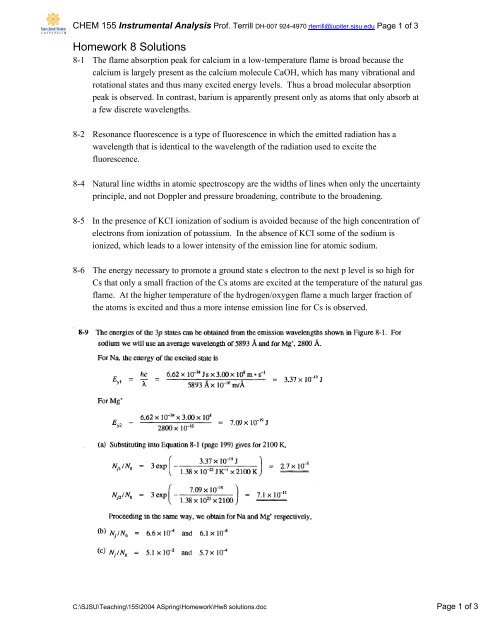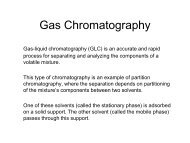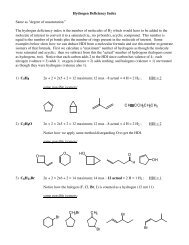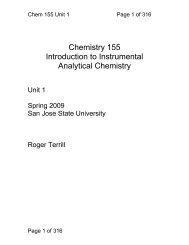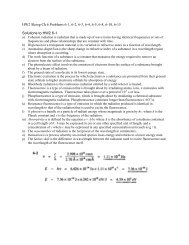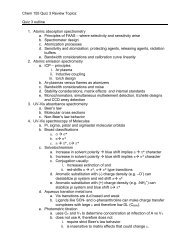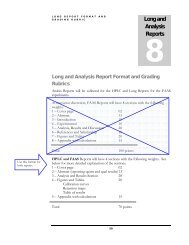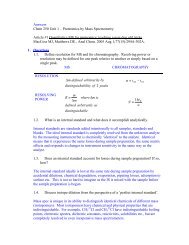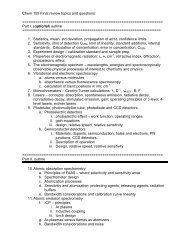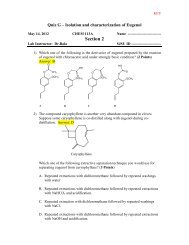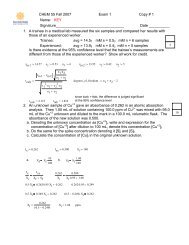HW 8 Solutions (PDF)
HW 8 Solutions (PDF)
HW 8 Solutions (PDF)
- No tags were found...
Create successful ePaper yourself
Turn your PDF publications into a flip-book with our unique Google optimized e-Paper software.
CHEM 155 Instrumental Analysis Prof. Terrill DH-007 924-4970 rterrill@jupiter.sjsu.edu Page 1 of 3Homework 8 <strong>Solutions</strong>8-1 The flame absorption peak for calcium in a low-temperature flame is broad because thecalcium is largely present as the calcium molecule CaOH, which has many vibrational androtational states and thus many excited energy levels. Thus a broad molecular absorptionpeak is observed. In contrast, barium is apparently present only as atoms that only absorb ata few discrete wavelengths.8-2 Resonance fluorescence is a type of fluorescence in which the emitted radiation has awavelength that is identical to the wavelength of the radiation used to excite thefluorescence.8-4 Natural line widths in atomic spectroscopy are the widths of lines when only the uncertaintyprinciple, and not Doppler and pressure broadening, contribute to the broadening.8-5 In the presence of KCI ionization of sodium is avoided because of the high concentration ofelectrons from ionization of potassium. In the absence of KCI some of the sodium isionized, which leads to a lower intensity of the emission line for atomic sodium.8-6 The energy necessary to promote a ground state s electron to the next p level is so high forCs that only a small fraction of the Cs atoms are excited at the temperature of the natural gasflame. At the higher temperature of the hydrogen/oxygen flame a much larger fraction ofthe atoms is excited and thus a more intense emission line for Cs is observed.C:\SJSU\Teaching\155\2004 ASpring\Homework\Hw8 solutions.doc Page 1 of 3
CHEM 155 Instrumental Analysis Prof. Terrill DH-007 924-4970 rterrill@jupiter.sjsu.edu Page 2 of 38-10. The key to solving this is simply in seeing the ordering of the energy levels.3s 3p 4s – the energy level diagram for Na Figure 8-1 is essential. Theenergy difference between the 3p and 3s state for sodium was 3.37x10 -19 J. Theenergy difference between the 4s and 3p state can be calculated from theemission wavelength, 1139 nm. The energy difference from 4s to 3s is simplythe sum of these two steps.8-11. This was a tricky one – but not that complex once you understand thedynamic. The low absorbance at low concentration implies the loss of U-atoms at low concentration. One loss mechanism is ionization. Ionization,just like for a weak acid for example, is more extensive at lowconcentration because of the equilibrium expression:K ION = [U n+ ] [e - ] / [U]Total U atom species entering the plasma - [U O ]U atoms left after ionization - [U] = [U O ] - x (this is what we want)U ions formed - [x]Electrons released - [e - ] = [x]K ION = x 2 / [U O ] – xNow drop the ‘ion’ subscript and the parenthesesKUo – Kx = x 2x 2 + Kx – KU O = 0 Quadratic… a = 1, b = K, c = -KU Ox = -b±(b 2 -4ac) 1/2 / 2ax = -K±(K 2 +4KU O ) 1/2 / 2 [U] = [U O ] – x = nonlinear at low [U O ] concentrations… see graphs on followingpage:C:\SJSU\Teaching\155\2004 ASpring\Homework\Hw8 solutions.doc Page 2 of 3
CHEM 155 Instrumental Analysis Prof. Terrill DH-007 924-4970 rterrill@jupiter.sjsu.edu Page 3 of 3Assumed ionization constant: K 10 4Concentration of ions:xKUo ( , )K K 2 4K . . Uo28 . 10 46 . 10 4U oxKU , o4 . 10 42 . 10 400 2 . 10 4 4 . 10 4 6 . 10 4 8 . 10 4 0.001U oFraction ionized:1xKU , oz0.1U ozU oz0.011 . 10 7 1 . 10 6 1 . 10 5 1 . 10 4 1 . 10 3 0.01 0.1C:\SJSU\Teaching\155\2004 ASpring\Homework\Hw8 solutions.doc Page 3 of 3


